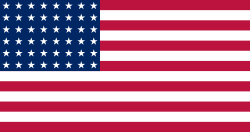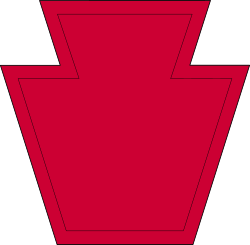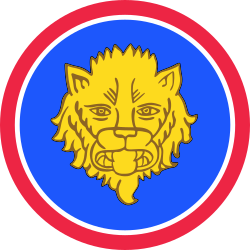12th Army Group
12th Army Group | |
|---|---|
Schulterabzeichen der 12th Army Group | |
| Aktiv | 14. Juli 1944 bis 1. August 1945 |
| Staat | |
| Streitkräfte | US-Streitkräfte |
| Teilstreitkraft | Army |
| Typ | Heeresgruppe |
| Kriege | Zweiter Weltkrieg |
| Oberbefehl | |
| Oberbefehlshaber | Omar N. Bradley |
| Chef des Stabes | Leven C. Allen |
Die 12th Army Group (deutsch 12. US-Heeresgruppe) war ein Großverband (Heeresgruppenkommando) der westlichen Alliierten im Zweiten Weltkrieg, der in den Jahren 1944 und 1945 aktiv war. Er stand unter US-amerikanischer Führung und war mit bis zu 1,3 Millionen Soldaten der größte Heeresverband in der amerikanischen Geschichte.
Geschichte
Während der Vorbereitung auf die Operation Overlord wurde von den Alliierten beschlossen, die beteiligten Armeen der US-Streitkräfte nach der ersten Phase der Operationen (durchzuführen von der britischen 21st Army Group) auf dem Kontinent einem amerikanischen Oberkommando zu unterstellen. Hierzu wurde im Oktober 1943 die 1st US Army Group (FUSAG) unter General Omar N. Bradley gebildet, der zugleich die 1. US-Armee führte. Am 14. Juli 1944 wurde dann die 12th Army Group unter Bradley im Vereinigten Königreich aktiviert, die die der FUSAG unterstellten Verbände bis auf wenige Ausnahmen übernahm. Ohne unterstellte Verbände blieb die FUSAG dennoch weiterhin bestehen. Mit dieser Maßnahme (Operation Quicksilver) sollte die Existenz einer weiteren US-Heeresgruppe in Großbritannien vorgetäuscht und die deutsche Führung über eine mögliche zweite Landung auf dem Kontinent im Unklaren gelassen werden.
Die 12th Army Group übernahm im weiteren Verlauf am 1. August 1944 in Frankreich die Kontrolle über die 1. (Courtney Hicks Hodges) und 3. US-Armee (George S. Patton). Ihr Oberbefehlshaber Bradley war zunächst in operativen Fragen dem Leiter der Bodenoperationen der Operation Overlord, dem britischen Feldmarschall Bernard Montgomery unterstellt, bis Anfang September das Supreme Headquarters Allied Expeditionary Force unter Dwight D. Eisenhower die Leitung der Operationen auf dem Kontinent übernahm. Die 12th Army Group bildete zu diesem Zeitpunkt das Zentrum der alliierten Heeresgruppen an der Westfront, nachdem Mitte August in Südfrankreich die 6th Army Group (Jacob L. Devers) in der Operation Dragoon gelandet war. Nördlich schloss sich die 21st Army Group unter Montgomery an. Die 12th Army Group wurde wenig später durch die 9. US-Armee (William Hood Simpson) verstärkt, die zuvor in der Bretagne eingesetzt war. Die Armeen der Heeresgruppe nahmen in der Zeit bis zur deutschen Ardennenoffensive im Winter 1944/45 an den Kämpfen am und im Vorfeld des Westwalls teil (u. a. Schlacht im Hürtgenwald, Schlacht um Aachen, Kämpfe in Lothringen).
Im Zuge der Abwehrmaßnahmen der Ardennenoffensive wurde die 9. US-Armee zeitweilig der 21st Army Group unterstellt. Im Januar 1945 wurde die 15. US-Armee (Leonard T. Gerow) der 12th Army Group zugeteilt. Im Februar 1945 durchbrachen die Truppen der Heeresgruppe den Westwall, setzten im März zur Überquerung des Rheins an und schlossen Anfang April den Ruhrkessel. Bis zum Kriegsende erreichten die Truppen der Heeresgruppe die Elbe und besetzten Teile Österreichs und der Tschechoslowakei.
Am 31. Juli wurde die Kontrolle über die US-Truppen in Europa dem neugebildeten Hauptquartier US Forces, European Theater (USFET) übertragen und die 12th Army Group am Folgetag aufgelöst.
Gliederung im Mai 1945
 12th Army Group (Omar N. Bradley)
12th Army Group (Omar N. Bradley) First Army (Courtney Hicks Hodges)
First Army (Courtney Hicks Hodges) VII Corps (J. Lawton Collins)
VII Corps (J. Lawton Collins) VIII Corps (Troy H. Middleton)
VIII Corps (Troy H. Middleton)
 Third Army (George S. Patton)
Third Army (George S. Patton) III Corps (James A. Van Fleet)
III Corps (James A. Van Fleet) V Corps (Clarence R. Huebner)
V Corps (Clarence R. Huebner) XII Corps (Stafford LeRoy Irwin)
XII Corps (Stafford LeRoy Irwin) XX Corps (Walton Walker)
XX Corps (Walton Walker)
 Ninth Army (William Hood Simpson)
Ninth Army (William Hood Simpson) XIII Corps (Alvan C. Gillem, Jr.)
XIII Corps (Alvan C. Gillem, Jr.) XVI Corps (John B. Anderson)
XVI Corps (John B. Anderson) XIX Corps (Raymond S. McLain)
XIX Corps (Raymond S. McLain)
 Fifteenth Army (Leonard T. Gerow)
Fifteenth Army (Leonard T. Gerow) XVIII Airborne Corps (Matthew B. Ridgway)
XVIII Airborne Corps (Matthew B. Ridgway) XXII Corps (Ernest N. Harmon)
XXII Corps (Ernest N. Harmon) XXIII Corps (Hugh J. Gaffey)[1]
XXIII Corps (Hugh J. Gaffey)[1]
Schlachtordnung am 8. Mai 1945
Am 8. Mai 1945 hatte die 12th Army Group folgende Schlachtordnung eingenommen:
 12th Army Group – General Omar N. Bradley
12th Army Group – General Omar N. Bradley First Army – General Courtney H. Hodges
First Army – General Courtney H. Hodges 78. Infanteriedivision – Major General Edwin P. Parker
78. Infanteriedivision – Major General Edwin P. Parker VII Corps – Lieutenant General J. Lawton Collins
VII Corps – Lieutenant General J. Lawton Collins 9. Infanteriedivision – Major General Louis A. Craig
9. Infanteriedivision – Major General Louis A. Craig 69. Infanteriedivision – Major General Emil F. Reinhardt
69. Infanteriedivision – Major General Emil F. Reinhardt 104. Infanteriedivision – Major General Terry de la Mesa Allen, Sr.
104. Infanteriedivision – Major General Terry de la Mesa Allen, Sr.
 Third Army – General George S. Patton, Jr.
Third Army – General George S. Patton, Jr. 1. Infanteriedivision – Major General Clift Andrus
1. Infanteriedivision – Major General Clift Andrus 2. Infanteriedivision – Major General Walter M. Robertson
2. Infanteriedivision – Major General Walter M. Robertson 9th Armored Division – Major General John W. Leonard
9th Armored Division – Major General John W. Leonard 70. Infanteriedivision – Major General Allison J. Barnett
70. Infanteriedivision – Major General Allison J. Barnett 97. Infanteriedivision – Brigadier General Milton B. Halsey
97. Infanteriedivision – Brigadier General Milton B. Halsey III Corps – Major General James Van Fleet
III Corps – Major General James Van Fleet 4. Infanteriedivision – Major General Harold W. Blakeley
4. Infanteriedivision – Major General Harold W. Blakeley 14th Armored Division – Major General Albert C. Smith
14th Armored Division – Major General Albert C. Smith 99. Infanteriedivision – Major General Walter E. Lauer
99. Infanteriedivision – Major General Walter E. Lauer
 V Corps – Major General Clarence R. Huebner
V Corps – Major General Clarence R. Huebner 16th Armored Division – Brigadier General John L. Pierce
16th Armored Division – Brigadier General John L. Pierce
 XII Corps – Major General Stafford LeRoy Irwin
XII Corps – Major General Stafford LeRoy Irwin 4th Armored Division – Major General William M. Hoge
4th Armored Division – Major General William M. Hoge 5. Infanteriedivision – Major General Albert E. Brown
5. Infanteriedivision – Major General Albert E. Brown 11th Armored Division – Major General Holmes E. Dager
11th Armored Division – Major General Holmes E. Dager- 26. Infanteriedivision – Major General Willard S. Paul
 90. Infanteriedivision – Major General Herbert L. Earnest
90. Infanteriedivision – Major General Herbert L. Earnest
 XX Corps – Major General Walton H. Walker
XX Corps – Major General Walton H. Walker 13th Armored Division – Major General John Millikin
13th Armored Division – Major General John Millikin 65. Infanteriedivision – Major General Stanley E. Reinhart
65. Infanteriedivision – Major General Stanley E. Reinhart 71. Infanteriedivision – Major General Willard G. Wyman
71. Infanteriedivision – Major General Willard G. Wyman 80. Infanteriedivision – Major General Horace L. McBride
80. Infanteriedivision – Major General Horace L. McBride
 Ninth Army – Lieutenant General William H. Simpson
Ninth Army – Lieutenant General William H. Simpson 2nd Armored Division – Major General Isaac D. White
2nd Armored Division – Major General Isaac D. White VIII Corps – Major General Troy H. Middleton
VIII Corps – Major General Troy H. Middleton 6th Armored Division – Major General Robert W. Grow
6th Armored Division – Major General Robert W. Grow 76. Infanteriedivision – Major General William R. Schmidt
76. Infanteriedivision – Major General William R. Schmidt 87. Infanteriedivision – Major General Frank L. Cullin, Jr.
87. Infanteriedivision – Major General Frank L. Cullin, Jr. 89. Infanteriedivision – Major General Thomas D. Finley
89. Infanteriedivision – Major General Thomas D. Finley
 XIII Corps – Major General Alvan C. Gillem, Jr.
XIII Corps – Major General Alvan C. Gillem, Jr. 30. Infanteriedivision – Major General Leland S. Hobbs
30. Infanteriedivision – Major General Leland S. Hobbs 35. Infanteriedivision – Major General Paul W. Baade
35. Infanteriedivision – Major General Paul W. Baade 83. Infanteriedivision – Major General Robert C. Macon
83. Infanteriedivision – Major General Robert C. Macon 84. Infanteriedivision – Major General Alexander R. Bolling
84. Infanteriedivision – Major General Alexander R. Bolling 102. Infanteriedivision – Major General Frank A. Keating
102. Infanteriedivision – Major General Frank A. Keating
 XVI Corps – Major General John B. Anderson
XVI Corps – Major General John B. Anderson 29. Infanteriedivision – Major General Charles H. Gerhardt
29. Infanteriedivision – Major General Charles H. Gerhardt 75. Infanteriedivision – Major General Ray E. Porter
75. Infanteriedivision – Major General Ray E. Porter 79. Infanteriedivision – Major General Ira T. Wyche
79. Infanteriedivision – Major General Ira T. Wyche 95. Infanteriedivision – Major General Harry L. Tawddle
95. Infanteriedivision – Major General Harry L. Tawddle
 XIX Corps – Major General Raymond S. McLain
XIX Corps – Major General Raymond S. McLain 3rd Armored Division – Brigadier General Doyle O. Hickey
3rd Armored Division – Brigadier General Doyle O. Hickey 8th Armored Division – Major General John M. Devine
8th Armored Division – Major General John M. Devine
 Fifteenth Army – Lieutenant General Leonard T. Gerow
Fifteenth Army – Lieutenant General Leonard T. Gerow 66. Infanteriedivision – Major General Herman F. Kramer
66. Infanteriedivision – Major General Herman F. Kramer 106. Infanteriedivision – Major General Donald A. Stroh
106. Infanteriedivision – Major General Donald A. Stroh XVIII Airborne Corps – Major General Matthew B. Ridgway
XVIII Airborne Corps – Major General Matthew B. Ridgway 5th Armored Division – Major General Lunsford E. Oliver
5th Armored Division – Major General Lunsford E. Oliver 7th Armored Division – Major General Robert W. Hasbrouck
7th Armored Division – Major General Robert W. Hasbrouck 8. Infanteriedivision – Major General Bryant E. Moore
8. Infanteriedivision – Major General Bryant E. Moore 82nd Airborne Division – Major General James M. Gavin
82nd Airborne Division – Major General James M. Gavin
 XXII Corps – Major General Ernest N. Harmon
XXII Corps – Major General Ernest N. Harmon 17th Airborne Division – Major General William M. Miley
17th Airborne Division – Major General William M. Miley 94. Infanteriedivision – Major General Harry J. Malony
94. Infanteriedivision – Major General Harry J. Malony
 XXIII Corps – Major General Hugh J. Gaffey
XXIII Corps – Major General Hugh J. Gaffey 28. Infanteriedivision – Major General Norman D. Cota[2]
28. Infanteriedivision – Major General Norman D. Cota[2]
Literatur
- Headquarters 12th Army Group (Final After Action Report), Volume 1.
Einzelnachweise
- ↑ Forrest C. Pogue: The Supreme Command. Appendix D: Forces Under SHAEF, 1944–45.
- ↑ Omar Bradley: A Soldier's Story. New York: Henry Holt and Company (1950), pp. 557–561.
Auf dieser Seite verwendete Medien
US Flag with 48 stars. In use for 47 years from July 4, 1912, to July 3, 1959.
XIX Corps shoulder sleeve insignia
Autor/Urheber: Reservafuerzapublica, Lizenz: CC BY-SA 3.0
Shoulder patch of the 66th Infantry Division, US Army
Shoulder sleeve insignia of the III Corps.
Beschreibung
A blue caltrop with three points that lie on a circle of 1 1/2 inch radius with a white triangle in the center with points that lie on a circle of 3/8 inch radius. The design is enclosed by a 1/8 inch Army green border.
Symbolism
The triangular design represents the numerical designation of the corps. The blue and white are the authorized colors used in distinguishing flags to represent corps.
Background
Shoulder Sleeve Insignia of the 79th Infantry Division (now the 79th U.S. Army Reserve Command).
- Description
- A blue triangular shield 2 1/2 inches (6.35 cm) in height by 2 1/8 inches (5.40 cm) in width, a Lorraine Cross within an orle. Cross and orle silver gray and the elements of each 1/8 inch (.32 cm) in width.
- Symbolism
- The Lorraine Cross was adopted as the insignia because it is a symbol of triumph and the 79th Division fought victoriously in the Lorraine Campaign during World War I.
- Background
- The shoulder sleeve insignia was originally approved for the 79th Division by telegram on 16 November 1918. It was officially announced by the War Department on 23 June 1922. It was redesignated for the 79th Command Headquarters (Divisional) on 14 October 1963. The insignia was redesignated for the 79th US Army Reserve Command on 22 April 1968.
W3C-validity not checked.
4th Infantry Division shoulder insignia :
I created this work during the course of my official duties. As a United States Army soldier, it is considered the work of the United States Federal Government, and as such is in the public domain. -- Steven Williamson (HiB2Bornot2B) - talk 15:49, 26 July 2007 (UTC)
US Army 87th Infantry Division Shoulder Sleeve Insignia
XXII Corps shoulder sleeve insignia
Representation of the United States Army XIII Corps insignia. Made with Photoshop.
US Army 5th Infantry Division Shoulder Sleeve Insignia
US Army 6th Armored Division Shoulder Sleeve Insignia
I created this work during the course of my official duties. As a United States Army soldier, it is considered the work of the United States Federal Government, and as such is in the public domain. -- Steven Williamson (HiB2Bornot2B) - talk 17:39, 26 July 2007 (UTC)
US Army 4th Armored Division Shoulder Sleeve Insignia
US Army 13th Armored Division Shoulder Sleeve Insignia
1st Infantry Division Combat Service Identification Badge
70th Inf Div patch
US Army VII Corps Shoulder Sleeve Insignia
Shoulder Sleeve Insignia of the 94th Infantry Division (now the 94th Regional Readiness Command).
- Description
- On a disc divided bend sinister silver gray and black fimbriated silver gray, all edged with a 1/8 inch (.32cm) black border, a black Arabic numeral "9" on the silver gray and a silver gray Arabic numeral "4" on the black. The diameter is 2 1/2 inches (6.35cm).
- Symbolism
- The insignia represents the numerical designation of the unit.
- Background
- The history of the shoulder sleeve insignia authorized for the U.S. Army Regional Support Command is as follows:
- A design featuring a Native American with bow and arrow was authorized for the 94th Division on 21 Jul 1922.
- The above design was superseded by approval of the design of a Puritan carrying a blunderbuss on his shoulder on 6 Sep 1923.
- The above approval was amended to change the wording of the description on 22 Dec 1923.
- The Puritan design was superseded by design featuring the Arabic numerals "9" and "4" on 5 Sep 1942.
- The "9/4" design was rescinded (cancelled) on 14 May 1956. The same letter reinstated the Puritan shoulder sleeve insignia, with a minor change in the design, for the 94th Infantry Division.
- The Puritan design was redesignated for the 94th Command Headquarters (Divisional) on 16 Oct 1963.
- The Puritan design was authorized for the 94th U.S. Army Reserve Command on 22 Apr 1968.
- The Puritan design was rescinded (cancelled) on 27 Nov 1991. The same letter reinstated the "9/4" design.
- The insignia was redesignated effective 16 July 2003 for the U.S. Army 94th Regional Readiness Command.
US 75th Infantry Division Shoulder Sleeve Insignia. The previous patch had the number colors inverted.
US Army 84th Infantry Division Shoulder Sleeve Insignia
US Army 2nd Armored Division Shoulder Sleeve Insignia
US Army 7th Armored Division Shoulder Sleeve Insignia
VIII Corps SSI
US Army 11th Armored Division Shoulder Sleeve Insignia
US Army 71st Infantry Division Shoulder Sleeve Insignia
Fifteenth US Army Shoulder Sleeve Insignia
28th Infantry Division Shoulder Sleeve Insignia
US Army 14th Armored Division Shoulder Sleeve Insignia
XXIII Corps shoulder sleeve insignia
US Army 69th Infantry Division Shoulder Sleeve Insignia
1st US Army Shoulder Sleeve Insignia
Shoulder Sleeve Insignia of the U.S. Ninth Army
US Army 8th Armored Division Shoulder Sleeve Insignia
US Army 5th Armored Division Shoulder Sleeve Insignia
102nd Infantry Division Shoulder Sleeve Insignia
- Upon a five pointed white star whose points lie in the circumference of an imaginary circle 3-1/2 inches (8.89 cm) in diameter a Native American's head with war bonnet in profile, face red, bonnet blue with outline of feathers in blue.
- The star to be superimposed upon a black shield, of dimensions such that the points of the star shall lie at a distance of 1/8 inch (.32 cm) from the perimeter.
Symbolism:
- The star has played an important part in our history from the days of the Colonies to the present time.
- The Native signifies the first and original American.
- These devices were originally established by the division to use as vehicle markings and to identify the vehicles as all American.
Background:
- The shoulder sleeve insignia was originally authorized for the 2d Division on 6 Nov 1918, officially announced by The Adjutant General letter, 21 Jun 1922, amended to correct the description on 7 Nov 1927 and redesignated for the 2d Infantry Division on 1 Aug 1942.
Work of Federal Government
9th Infantry Division patch
35th Infantry Division Shoulder Sleeve Insignia
;Description
- Issuing from the sinister side of a 2-1/4 inch white square, flat side up, a blue dragon’s head all within a 1/8 inch blue border. (The dragon’s tongue points to dexter base corner.) Immediately above and touching the insignia a blue arc tab 11/16 inch in width, 2 1/2 inches in length containing white letters "AIRBORNE" 5/16 inch in height.
- Symbolism
- The dragon’s head is representative of cunning, endurance and ferocity against enemies and is symbolic of the strategy and powerful attack of the Corps, Also known as the 'Gaggin Dragon'.
- Background
- Originally approved 15 Feb 1944 and subsequently amended to include the Airborne Tab on 1 May 1950.
On a blue disc within a white edge, a gold lion's face all within a red border.
1. The blue is for infantry, while the red represents artillery support.
2. The lion's face represents strength and power.Shoulder Sleeve Insignia of the 78th Infantry Division.
- Description
- On a red semi-disc 3 inches (7.62cm) in diameter, a white bolt of lightning from sinister chief to dexter base, all within a 1/8 inch (.32cm) green border.
- Symbolism
- The lightning flash on the red background alludes to the combat record of the division likened to a "bolt of lightning…" and to its designation as the "Lightning Division."
- Background
- The shoulder sleeve insignia was originally approved for the 78th Division on 27 May 1922. It was retained for the 78th Division (Training) on 11 Sep 1959. The insignia was redesignated on 1 Oct 1993 for the 78th Division (Exercise) and the description revised to provide metric measurements. The insignia was redesignated for the 78th Division (Training Support) on 17 Oct 1999.
US Army 16th Armored Division Shoulder Sleeve Insignia
US Army 9th Armored Division Shoulder Sleeve Insignia
Shoulder Sleeve Insignia of the 89th Division (now the 89th Regional Readiness Command).
- Description
- On a blue disc 1 5/8 inches (4.13cm) in diameter and within a white annulet 3/16 inch (.48cm) in width a white letter “W” formed of curved lines 3/16 inch (.48cm) in width and joining the annulet, all within a 1/8 inch (.32cm) red border. The overall dimension is 2 ¼ inches (5.72cm) in diameter.
- Background
- The shoulder sleeve insignia was originally approved for the 89th Division on 25 Oct 1918 by telegram but not officially announced by the War Department until 23 Jun 1922. It was amended on 21 Dec 1948 to change the colors and reword the measurements. The insignia was approved for the 89th U.S. Army Reserve Command on 26 Jul 1974. On 16 Apr 1996 the insignia was reassigned and approved for the 89th Regional Support Command.
United States Army 17th Airborne Division insignia. Made with Photoshop.
































































